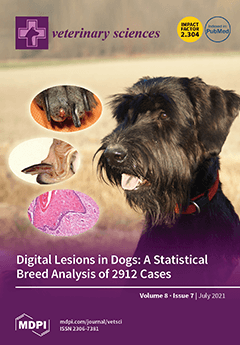Brucellosis is an important zoonotic disease caused by members of the genus
Brucella. Camel brucellosis has been reported in almost all camel-rearing countries in Africa and Asia. A cross-sectional study was conducted between February 2020 and February 2021 in Galkayo, Garowe, and
[...] Read more.
Brucellosis is an important zoonotic disease caused by members of the genus
Brucella. Camel brucellosis has been reported in almost all camel-rearing countries in Africa and Asia. A cross-sectional study was conducted between February 2020 and February 2021 in Galkayo, Garowe, and Bosaso districts in the Puntland State of Somalia to investigate the seroprevalence and risk factors of brucellosis in camels. A competitive enzyme-linked immunosorbent assay (c-ELISA) was used to detect anti-
Brucella antibodies, while a structured questionnaire was used to collect epidemiological data. A total of 441 camel sera were screened against
Brucella antibodies. Thirty-one (7%; 95% CI: 4.8–9.8%) samples were positive, and thirteen (54.2%; 95% CI: 32.8–74.4%) out of the twenty-four farms sampled had at least one seropositive animal. Galkayo district had the highest number of
Brucella-seropositive camels (10.3%), followed by Bosaso district (8.6%), while Garowe district had the lowest number of seropositive camels (1.4%). The binary logistic regression model revealed that camels in Galkayo district (
p = 0.015; OR: 9.428; 95% CI: 1.539–57.755), camels from large herd sizes of >50 animals (
p = 0.019; OR: 5.822; 95% CI: 1.336–25.371), and those in contact with small ruminants (
p = 0.011; OR: 10.941; 95% CI: 1.728–69.285) were significantly associated with seropositive cases of camel brucellosis in the Puntland State of Somalia. The present study shows that
Brucella infections in camels are prevalent in the three districts covered by the study. This poses a public health risk, because milk from these camels is used for human consumption. Studies focusing on the isolation of
Brucella strains in camels and investigating brucellosis in ruminants and humans are recommended in the study area. Validation of serological tests—including c-ELISA—for
Brucella antibody detection in camels is also needed.
Full article






